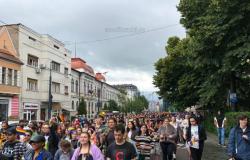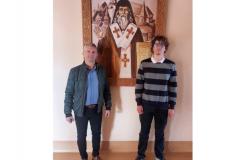During the Easter holidays, Romanians can also go to other less known places to spend their free days. According to the tourism consultant Traian Bădulescu, who is the spokesperson of ANAT, rural tourism is increasingly on the list of those who want to spend Easter outside the big cities. “Tourists are increasingly looking for authentic experiences. They want to get involved in local customs, participate in religious services and taste traditional Easter dishes. Romanians value authentic experiences, local traditions and customs. In the rural villages, tourists can interact with the locals, taste traditional dishes and discover the authentic lifestyle. I notice an increasing inclination of Romanians towards rural tourism, especially since we have urbanized more and more in the last 20 years and many of us no longer have grandparents or relatives in the country. Also, rural tourism offers an escape from the hustle and bustle of cities. People are looking for peace, clean air and natural landscapes”, said Bădulescu.
The ANAT representative says that the rates for rural and agro-tourism guesthouses are among the most affordable, usually ranging between 100-120 lei per room per night (without meal services), for a 2-bed guesthouse, up to 400-600 lei lei room per night at a guesthouse of 4 or 5 daisies, with all meals included.
Here are the five villages in Romania recommended by the National Association of Travel Agencies (ANAT) for the Easter holidays.
The village of Viscri
“Located in the heart of Transylvania, in Brasov county, it is a hidden gem that attracts tourists from all over the world. This village was made famous by King Charles III. King Charles House (pictured) is a major tourist attraction. The king often visited this village and even bought a property here in 2006. The house dates back to 1875 and has been carefully renovated, preserving the traditional elements. Visitors can explore two of the rooms of the house, the exhibitions in the barn and relax at the café with a terrace, but they can also stay here. A person will pay between 150 and 170 euros per night, with “all inclusive” services – all meals included, guided excursions and activities during the day, entrance fees, transport and taxes. The facades of houses over 100 years old are impressive”, says Traian Badulescu.
The houses in Viscri are built of solid fir wood, with high gates and roofs of straw or shingles. The Fortified Evangelical Church, with a history stretching back to the 12th century, impresses with its architecture and is among the most remarkable places of worship in Transylvania. The church tower offers a captivating panorama of the village and its surroundings. Inside the church, visitors are invited to explore the museum that illustrates the life and organization of the Saxon community, as well as the Slăninei Chamber. Tourists have the opportunity to participate in various activities, including guided tours on the bicycle trails, wagon rides through the surroundings, tastings of local products and excursions through the surrounding forests.
Şirnea (Fundata, Braşov)
According to Traian Bădulescu, this is the first “tourist village” in Romania. Located in the Fundata commune of Braşov county, in the Rucăr-Bran corridor, at an altitude of approximately 1,200 meters, Şirnea is one of the few places where tourists can enjoy impressive views of the Bucegi and Piatra Craiului mountains. Among the main tourist activities that can be carried out here are nature walks and mountain trails. Tourists can discover the village of Şirnea on foot, following the ecotourism route T1 or choosing a circuit through the Piatra Craiului Mountains. Tourists can also taste the local products: periwinkle soup, home-made sausages or pan-fried bulzu. Plus plum brandy!
Botiza (Maramureş)
Enjoy a trip to the heart of Maramureş and discover the beauty of Botiza village, a place with authentic traditions and picturesque landscapes. Known for its traditional crafts, Botiza is a paradise of wool carpets, where traditional motifs find life in vibrant colors, using only vegetable pigments. Each carpet is a masterpiece of craftsmanship and a story intertwined with old traditions passed down from generation to generation.
The village is also known for the fact that the Wooden Church was included in the UNESCO heritage, built in 1699 and carefully restored in 1899. The high spire, delicate sculptures and interior paintings are testimonies of the rich history and culture of the place. In addition to its cultural heritage, Botiza also offers opportunities for relaxation and adventure in nature: from walks on forest paths to exploring neighboring villages and tasting traditional dishes.
Rimetea (Western Mountains)
Rimetea village is famous for its traditional architecture: its houses built of massive fir wood, with high gates and whitewash. Those who want to spend their holidays here can enjoy mountain trails on Piatra Secuiului, the limestone massif that shadows the village, where the sun rises twice.
Sibiel (Mărginimea Sibiului)
Sibiel is especially known for the wooden Church that was included in the UNESCO World Heritage list. Built in 1632, it is one of the oldest wooden churches in the area. Tourists will be able to taste authentic gastronomy here, such as cottage cheese, telemeau and cheese. As for the traditions of Sibiel, the locals have preserved the old harbor for several centuries and continue to practice transhumance.
ROMANIA, IN THE TOP 10 COUNTRIES WITH DEVELOPED AGRO-TOURISM
Romania is positioned very well internationally in terms of agritourism and rural tourism, says the tourism consultant. In Europe, for over 20 years, we have been in the top 10 countries with developed agritourism and rural tourism, along with France, Austria, Spain, Italy, Greece, or globally, with California (USA), Brazil, Taiwan, the Philippines .
The increasing number of agritourism guesthouses, the special natural setting, well-preserved traditions and customs are assets in favor of rural tourism and agritourism in our country.
“Agritourism together with rural tourism represents the only form of tourism in Romania that appeared from scratch after 1990. It has developed strongly from year to year. Among the main factors that have supported this form of tourism are hospitality, traditions, the natural setting, the privacy offered by guesthouses. If in the first years of Romanian rural tourism, the majority of tourists who especially wanted authenticity were foreigners, in the last 20 years Romanian tourists have also started looking for a more rural setting. One of the reasons can be the accelerated urbanization and globalization of recent years,” Traian Bădulescu reports.
Tags: villages traditional Easter Brasov
-





